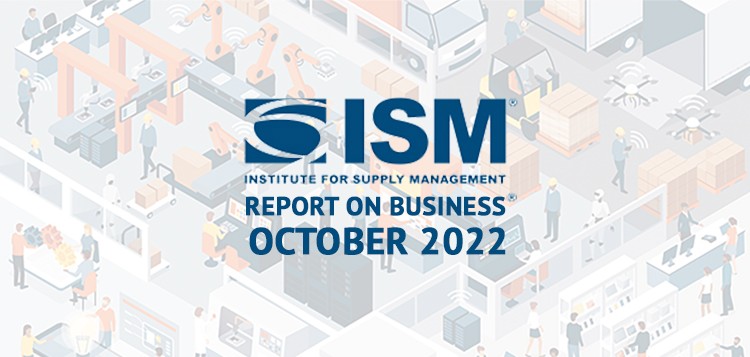October 2022 Manufacturing ISM® Report On Business® Indicates Slip Toward Contraction

Those following the Manufacturing ISM® Report On Business® this year know it’s been showing a downward trajectory for the past 12 months, save for a few fluctuations and an occasional plateau. In October, it slipped yet again, bringing it much closer to the benchmark for economic contraction. November stands to be a telling month — one that’s already receiving sour sentiments from industry analysts and executives alike.
October’s ISM Report: By the numbers
While October’s ISM Report is concerning for many manufacturers, the news didn’t come as much of a surprise. The index has slowly declined throughout the year, and October marks a two-year low for the PMI, settling at 50.2. There’s plenty of volatility among the metrics, hinting at more slippage to come.
The New Orders Index stands at 49.2, up from 47.1 in September. Employment is also up 1.3 points, barely breaking into expansion territory. And while production is up 1.7 points, there’s concern among executives that it’s temporary.
“Customer demand has been slower for two months. Production is decreasing our inventory and [we are] implementing forecasts carefully. The headwind seems to be very strong, so we need to be prepared for that,” says one executive.
On the other side of the report are considerable dips. Supplier Deliveries plummeted 5.6 points into contraction territory, as did Order Backlogs. While Prices fell 5.1 points, Inventories also dropped 3 points, signaling continued supply chain constraints. Imports and Exports were also down more than a point each, speaking to broader economic concerns on the horizon.

Looming fears of economic recession
As evidenced by the ISM Report, the U.S. is on the precipice of economic contraction, and there’s growing concern that the country could soon face a recession. Recession tends to start in the manufacturing industry, and the combination of lower order volumes, higher stockpiles, and decreased demand don’t bode well for the nation’s economy.
It’s not just the manufacturing space that’s pointing to recession. The Treasury Yield Curve, long seen as a tool to monitor overall economic stability, recently inverted. Most experts and Wall Street analysts believe that this correlation — combined with several other economic indicators — spells stagnancy on the horizon.
Recession fears exist abroad, too, with alarm bells already sounding in Europe. Instability caused by the Russian aggression in Ukraine — along with accompanying soaring energy prices and snarled supply chains — indicates the entire European bloc is already in recession. Overall, it’s a bad sign for the U.S., which could soon be feeling the rippling effects of global economic turbulence.
Preparations for turbulence
U.S. manufacturers are bracing for the impact of a recession. They are planning ahead, lowering production and inventories, and forecasting for the future. Some producers are experimenting with promotions to increase orders so they can maximize capacity in anticipation of an economic slowdown.
While some industry leaders worry international conditions will continue to affect the economy both here and abroad, they hope 2023 will be a positive year with at least moderate growth. Planning is key.